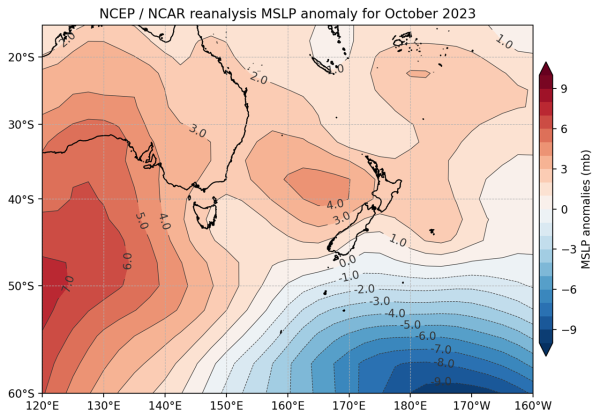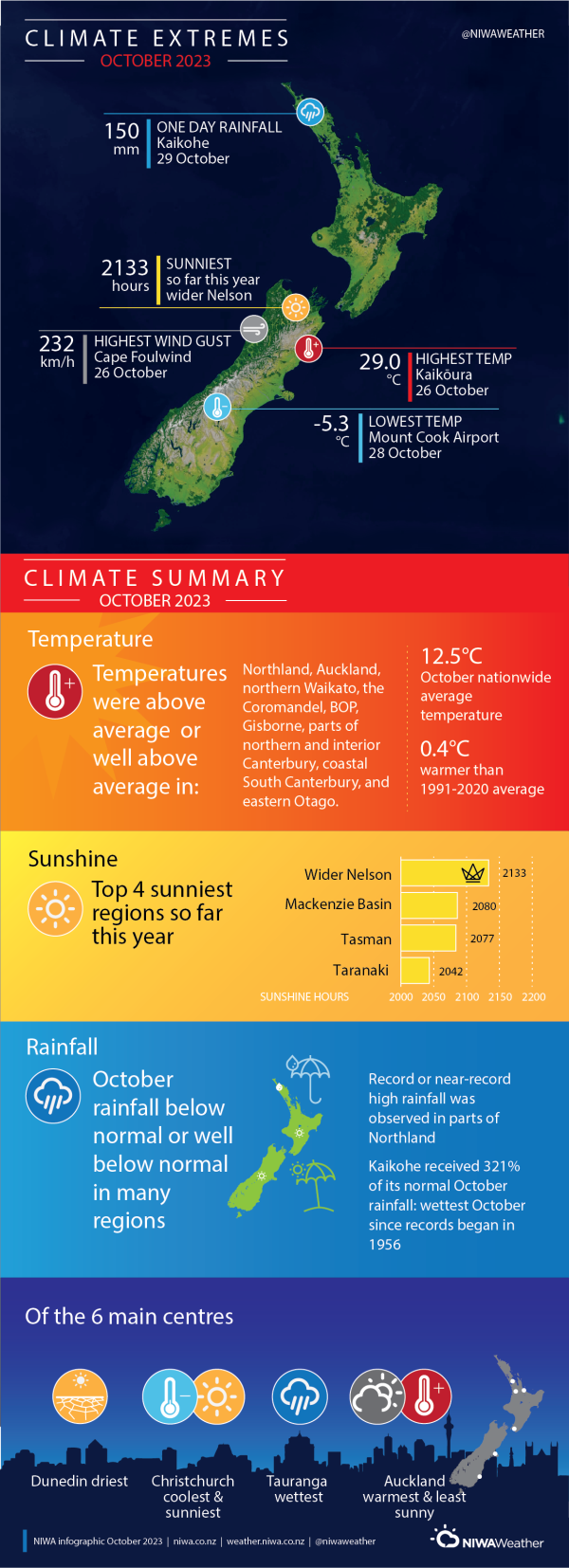A month of large temperature swings; very wet in Northland
|
Temperature |
Temperatures were above average (0.51°C to 1.20°C above average) or well above average (>1.20°C above average) in much of Northland, Auckland, northern Waikato, the Coromandel, Bay of Plenty, Gisborne, parts of northern and interior Canterbury, coastal South Canterbury, and eastern Otago. Below average temperatures (0.51°C to 1.20°C below average) were observed in the central and lower West Coast. Near average temperatures (±0.50°C of average) occurred in western Waikato, the lower half of the North Island, Tasman, Nelson, Marlborough, central and interior Canterbury, much of the West Coast, interior Otago, and Southland. |
|
Rainfall |
Rainfall was above normal (120-149% of normal) or well above normal (>149% of normal) in much of Northland, coastal Gisborne, and interior South Canterbury. Below normal (50-79% of normal) or well below normal (<50% of normal) rainfall was observed in southern Auckland, much of Waikato, Bay of Plenty, Hawke’s Bay, Taranaki, Manawatū-Whanganui, Wellington, Tasman, Nelson, Marlborough, coastal Canterbury, the upper West Coast, much of Otago, and Southland. Near normal rainfall (80-119% of normal) was observed elsewhere. |
|
Soil Moisture |
At the end of the month, soil moisture levels were higher than normal across Northland, northern Auckland, the Coromandel, the east coast of the North Island, northern and central Canterbury, interior Otago, and the lower West Coast. Below normal soil moisture was observed in interior Hawke’s Bay, Nelson, Marlborough Sounds, coastal central Canterbury, and western Southland. Elsewhere, soil moisture levels were generally near normal. |
Overview
October 2023 was characterised by higher than normal mean sea level pressure (MSLP) over the Tasman Sea and the North Island, with lower than normal pressure located south of Aotearoa New Zealand. This produced more westerly airflows than normal, particularly over the South Island, which is typical of an El Niño pattern. In fact, there were several strong to damaging wind events through the month that affected the South Island and lower North Island (see Highlights and extreme events section for details). Twenty-one locations experienced record or near-record maximum wind gusts for October. However, the month also featured periodic fronts from the Southern Ocean which brought occasional cold spells and even low-elevation snow to the South Island. This included snow to lake level in Queenstown and flurries in Dunedin’s CBD on 27 October. In addition, the end of October saw the remnants of ex-Tropical Cyclone Lola move out of the tropics and affect the upper North Island with heavy rainfall and strong winds.
Temperatures were above average (0.51°C to 1.20°C above average) or well above average (>1.20°C above average) in much of Northland, Auckland, northern Waikato, the Coromandel, Bay of Plenty, Gisborne, parts of northern and interior Canterbury, coastal South Canterbury, and eastern Otago. Below average temperatures (0.51°C to 1.20°C below average) were observed in the central and lower West Coast. Near average temperatures (-0.50°C to +0.50°C of average) occurred in western Waikato, the lower half of the North Island, Tasman, Nelson, Marlborough, central and interior Canterbury, much of the West Coast, interior Otago, and Southland.
The nationwide average temperature in October 2023 was 12.5°C. This was 0.4°C above the 1991-2020 October average from NIWA’s seven station temperature series which begins in 1909. While westerly winds delivered above average to well above average temperatures at times through the month, this was offset by periods of sharply cooler southerlies, leading to a near average month for the country as a whole.
Rainfall was above normal (120-149% of normal) or well above normal (>149% of normal) in much of Northland, coastal Gisborne, and interior South Canterbury. Below normal (50-79% of normal) or well below normal (<50% of normal) rainfall was observed in southern Auckland, much of Waikato, Bay of Plenty, Hawke’s Bay, Taranaki, Manawatū-Whanganui, Wellington-Wairarapa, Tasman, Nelson, Marlborough, coastal Canterbury, the upper West Coast, much of Otago, and Southland. Near normal rainfall (80-119% of normal) was observed elsewhere.
Further Highlights:
- The highest October temperature was 29.0°C, observed at Kaikōura on 26 October.
- The lowest October temperature was -5.3°C, observed at Mount Cook Airport on 28 October.
- The highest 1-day rainfall was 150 mm, recorded at Kaikohe on 29 October.
- The highest wind gust was 232 km/h, observed at Cape Foulwind on 26 October.
- Of the six main centres in October 2023, Auckland was the warmest and least sunny, Christchurch was the coolest and sunniest, Tauranga was the wettest, and Dunedin was the driest.
- Of the available, regularly reporting sunshine observation sites, the sunniest four regions in 2023 so far are wider Nelson (2133 hours), Mackenzie Basin (2080 hours), Tasman (2077 hours), and Taranaki (2042 hours).
Download
Climate Summary October 2023 [PDF 4.35 MB]
Climate Statistics October 2023 [PDF 156KB]



